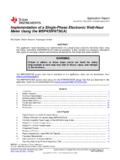Transcription of ATSC 3.0 Transition and Implementation Guide - …
1 ATSC Transition and Implementation Guide 2 INTRODUCTION This document was developed to provide broadcasters with ATSC information that can inform investment and technical decisions required to move from ATSC to ATSC It also guides broadcasters who are planning for its adoption while also planning for channel changes during the FCC Spectrum Repack Program. This document, finalized September 9, 2016, will be updated periodically as insight and additional information is made available from industry testing and Implementation of the new standard. This document was developed by the companies and organizations listed in the Appendix. Updates to the Guide are open to input from all companies and individuals that wish to contribute.
2 Those interested in suggesting changes or updates to this document can do so at ATSC Transition and Implementation Guide 3 EXECUTIVE SUMMARY Television service continues to evolve as content distributors from traditional cable operators to internet-delivered services utilize the latest technologies to reach viewers and offer a wide variety of program choices. New receiving devices are easily connected to the internet, which relies on the language of Internet Protocol (IP) to transport content. Now terrestrial broadcasters are preparing both for the adoption of an IP-ready next-generation digital TV (DTV) standard and a realignment of the TV spectrum. Viewers are already buying high-quality displays that respond to 4K Ultra HDTV signals and High Dynamic Range (HDR) capabilities.
3 Immersive and personalized audio is also emerging, with the ability to enhance the quality and variety of audio. To keep pace with these innovations, and to set the stage for additional advances in the future, broadcasters now have the option to move forward with a new broadcast television transmission standard. The Advanced Television Systems Committee (ATSC), through a cooperative effort by over 125 member organizations from the broadcast, consumer electronics, cable, satellite, motion picture, professional broadcast equipment, computer, and integrated circuit industries, has developed the ATSC television standard the world s first IP-based broadcast service. This next-generation TV ATSC transmission standard is the glue that enables broadcast protocol to exist in an internet environment.
4 The standard will permit broadcasters to offer innovative technologies and services to the public, including: Visually stunning pictures on large-screen televisions with superior reception; Broadcast programming with multiple consumer-friendly features, such as interactivity and personalized audio, which exceed those available through the current broadcast standard; Access to unlimited viewing of local and national news and the most popular sports and entertainment programming, and trusted educational and children s programming, via mobile devices such as tablets and smartphones; Seamless integration of broadcast programming with other IP services, with the ability to provide state-of-the-art security that content owners depend upon; Advanced emergency alert information backed up with live, professional reporters and connections of public safety officials with the public; ATSC Transition and Implementation Guide 4 Datacasting that will offer a new broadband data pipe into the home, thereby giving content providers another means for distributing large video and other digital files to consumers, and providing enhanced opportunities for essential public services including education and public safety.
5 And The ability to geotarget news, weather, and other programming. Next-generation TV transmissions will operate within broadcasters existing 6 MHz television channel, and be subject to the same radio frequency interference constraints and requirements that apply to the current DTV standard. No additional spectrum is required, nor has it been requested from the FCC. Next-generation TV services can be deployed within stations existing coverage contours without causing interference to current digital TV stations. Because ATSC offers significant advancements and capabilities beyond its predecessor, it is not backwards-compatible with the 20-year-old ATSC transmission system. To accomplish a seamless Implementation of next-generation TV without disenfranchising viewers, the industry will deploy this new technology in parallel with the existing digital television ATSC Transition and Implementation Guide 5 standard in a voluntary, market-based manner.
6 Parallel Implementation will mean that some broadcasters in each market will deploy next-generation ASTC TV, while others will continue to transmit using the current ATSC standard. With this model, broadcasters in each market will share in order to simulcast their respective signals, so that all viewers can receive programming from their local stations in both the current DTV and new TV formats, all free and over-the-air. Like mobile carriers today, which are free to choose when and how to deploy new standards, broadcasters will have the option of choosing when and whether to enhance their current service with ATSC Broadcasters will also have the option to build Single Frequency Networks (SFNs), which can extend or improve existing coverage, particularly for indoor and mobile device reception.
7 SFNs can also enable geotargeted advertising. ATSC can also unlock new opportunities for broadcasters and their advertising-based business model: Targeted Advertising. Channel watermarking allows targeting capabilities, and the IP return path enables the ability to measure audience activity for broadcasters advertising customers. Targeted Content. ATSC targeting ability also allows broadcasters to better reach narrow audiences with niche content that can increase value for advertisers. Subscription Services. New ways to support conditional access for freemium, one-time, and premium services. More Channels. Efficient video and audio compression in the ATSC standard will significantly boost effective bandwidth, by a factor of 3 or more, the number of HD program streams a broadcaster can transmit in the current 6 MHz channel of spectrum.
8 Mobile Services. Seamless delivery of programs and data services will be specifically targeted to portable and mobile devices. Greater Capacity. A system can support a third-party offloading business where data, video and other bandwidth-intensive content (such as software updates for devices) can be transmitted over broadcast networks for edge storage or delivery to non-household destinations. Today s wireless service and streaming video providers, for example, have acute needs for greater capacity to cost-effectively move their content as close to their customers as possible. Second Screen. The ability to deliver program related second-screen content by either Over the Air (OTA), or OTT distribution and interactive content using the IP return channel.
9 Plan Now for ATSC : Realize Savings, Maximize Investment and Return For those broadcasters wanting to take full advantage of ATSC s many capabilities, early planning is critical. Creating a blueprint of the desired capabilities, their relative importance, and how they will be implemented, is a complex task that will require advance planning from multiple disciplines within a station, or group of stations. ATSC Transition and Implementation Guide 6 Broadcasters should identify any potential redundancies for tower work or equipment with a future ATSC adoption, potentially saving investment costs by not having to do tower work twice once as the result of the Spectrum Repack and another time to optimize for ATSC This effort can reduce capital requirements in a number of ways: Making the right choice of transmitter, RF system and antenna components that will support a future move to ATSC , even if this means that stations must make an additional investment beyond the FCC repack reimbursement.
10 Purchasing the components that will support stations future ATSC plans can greatly reduce expenses during an ATSC Transition . If a new antenna system must be purchased for a channel change, making sure that the antenna conforms to the RF requirements for ATSC adoption. If a new transmitter will be required for a channel change, broadcasters should evaluate and pick products that are software-upgradable to ATSC , and have the ability to easily add additional amplification to support the peak power requirements related to Vpol for ATSC Eventual installation of ATSC equipment could mean changes to tower and tower site infrastructure. If broadcasters incorporate ATSC into tower structural engineering studies, tower modifications, and transmitter, RF system and antenna installations during the Spectrum Auction Repack, they will pay only once for potentially expensive and time-consuming work.




